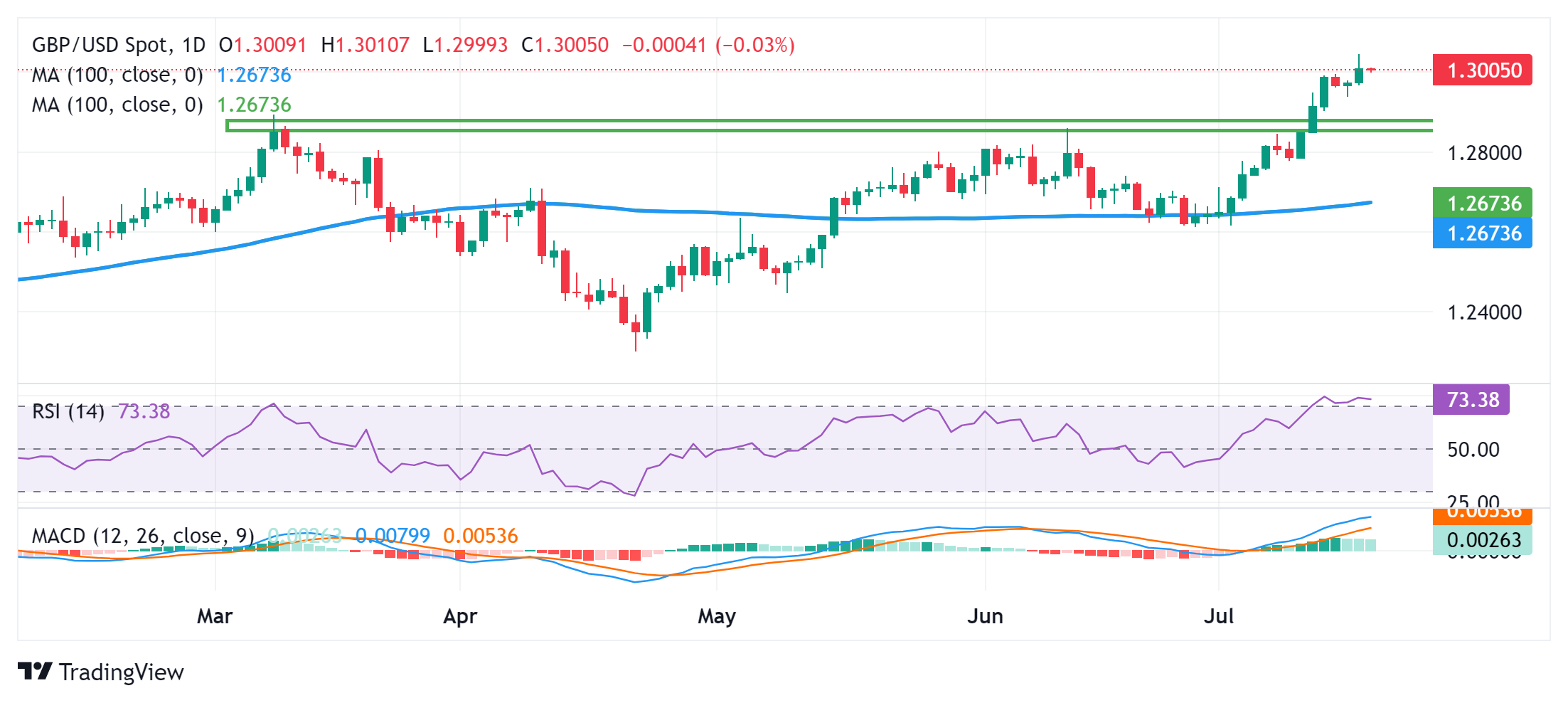- GBP/USD falls on Thursday amid some USD buying.
- A slightly overbought RSI seems to be holding back bulls from opening new positions.
- The technical setup suggests that the path of least resistance is to the upside.
The GBP/USD pair is trading with a slightly negative bias at the start of the Asian session on Thursday, although it lacks any follow-through selling and remains well within reach distance of the one-year peak touched the previous day. Spot prices are currently hovering around the psychological mark of 1.3000 and look set to extend the recent uptrend seen over the past three weeks or so.
A modest rebound in US Treasury bond yields helps the US Dollar (USD) to recover some of the previous day’s heavy losses to a near four-month low, which, in turn, is seen as a headwind for the GBP/USD pair. That said, the growing acceptance that the Federal Reserve (Fed) will begin the rate-cutting cycle in September, coupled with the strong underlying bullish tone in global equity markets, could limit the safe-haven US Dollar’s upside.
Meanwhile, data released on Wednesday showed that UK inflation rose slightly more than expected, coming in at 2% year-on-year for June. This adds to better-than-expected GDP growth of 0.4% in May and reduces the chances of a rate cut by the Bank of England (BoE) in August. This could continue to support the British Pound and further help limit the downside of the GBP/USD pair, warranting some caution from the bears.
From a technical perspective, the recent break through the previous yearly high, around the 1.2895 region, was seen as a fresh trigger for the bulls. That said, the Relative Strength Index (RSI) on the daily chart is showing overbought conditions and makes it prudent to wait for a short-term consolidation or a modest pullback before the next leg higher. However, any significant dip will likely attract fresh buyers near the 1.2965 zone and remain limited.
The latter is closely followed by the weekly low, around the 1.2940-1.2935 region touched on Tuesday, which if broken decisively could pave the way for a drop back towards the 1.2900 mark. This level should now act as a pivotal point, below which the GBP/USD pair could extend the correction towards the intermediate support near the 1.2855 zone en route towards the 1.2820-1.2815 region and the 1.2800 round mark.
On the upside, the push beyond the yearly peak, around the 1.3045 zone set on Wednesday, should allow the bulls to reclaim the 1.3100 mark. The subsequent move higher has the potential to lift the GBP/USD pair towards the 1.3140 region, or the July 2023 high.
The British Pound FAQs
The Pound Sterling (GBP) is the oldest currency in the world (886 AD) and the official currency of the United Kingdom. It is the fourth most traded currency unit in the world, accounting for 12% of all transactions and an average of $630 billion a day, as of 2022.
Its key currency pairs are GBP/USD, also known as the “Cable,” which accounts for 11% of the forex market, GBP/JPY, or the “Dragon” as it is known to traders (3%), and EUR/GBP (2%). The British Pound is issued by the Bank of England (BoE).
The most important factor influencing the value of the British Pound is the monetary policy decided by the Bank of England. The Bank of England bases its decisions on achieving its main objective of “price stability”, i.e. a stable inflation rate of around 2%. Its main tool for achieving this is the adjustment of interest rates.
When inflation is too high, the Bank of England tries to contain it by raising interest rates, making credit more expensive for individuals and businesses. This is generally positive for the GBP, as higher interest rates make the UK a more attractive place for global investors to park their money.
When inflation is too low, it is a sign that economic growth is slowing. In this scenario, the BoE will consider lowering interest rates to make credit cheaper, so that companies borrow more to invest in growth-generating projects.
The data released gauges the health of the economy and can influence the value of the Pound. Indicators such as GDP, manufacturing and services PMIs, and employment can influence the direction of the Pound.
A strong economy is good for the British Pound. Not only does it attract more foreign investment, but it may encourage the Bank of England to raise interest rates, which will directly strengthen the British Pound. Conversely, if economic data is weak, the British Pound is likely to fall.
Another significant indicator for the pound is the trade balance. This indicator measures the difference between what a country earns from its exports and what it spends on imports during a given period.
If a country produces highly sought-after exports, its currency will benefit exclusively from the additional demand created by foreign buyers who wish to purchase these goods. Therefore, a positive net trade balance strengthens a currency and vice versa for a negative balance.
Source: Fx Street
I am Joshua Winder, a senior-level journalist and editor at World Stock Market. I specialize in covering news related to the stock market and economic trends. With more than 8 years of experience in this field, I have become an expert in financial reporting.








